Krishna's Butterball
Krishna's Butterball (also known as Vaan Irai Kal[1] and Krishna's Gigantic Butterball) is a gigantic granite boulder resting on a short incline in the historical coastal resort town of Mamallapuram in Tamil Nadu state of India.[2]
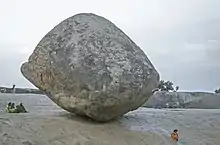

Being part of the Group of Monuments at Mamallapuram, a UNESCO World Heritage Site built during 7th- and 8th-century CE as Hindu religious monuments by the Pallava dynasty, it is a popular tourist attraction.[3][4][5] It is listed as a protected national monument by the Archeological Survey of India.[6]
Etymology
The original name, Vaan Irai Kal, according to the Atlas Obscura, translates from Tamil as "Stone of Sky God".[1] According to Hindu mythology, lord Krishna often stole butter from his mother's butter handi; this may have led to the namesake of the boulder.[1] In 1969, a tour-guide is said to credit its present name, Krishna's Butterball, to Indira Gandhi who was on a tour of the city.[7]
History
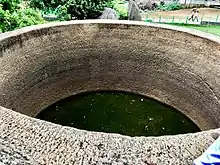
The Pallava king Narasimhavarman (630–668 CE) also made a failed attempt to move the boulder.[1] The Indian Tamil king Raja Raja Chola (985 and 1014 CE) was inspired by the balance of this massive stone boulder and it led to the creation of never-falling mud dolls called Tanjavur Bommai, which having a half-spherical base tends to come back to its original position every time one tries to make it fall. In 1908, then-governor of the city Arthur Havelock made an attempt to use seven elephants to move the boulder from its position due to safety concerns, but with no success. On October 12th 2019, Indian Prime Minister Narendra Modi and Chinese President Xi Jinping took a photo in front of Krishna's Butterball holding hands during their second "informal summit".[8]
Details
The boulder is approximately 6 meters high and 5 meters wide and weighs around 250 tons.[9] It seems to float and barely stand on a slope on top of 1.2-meter (4 ft) high plinth which is a naturally eroded hill, and is said to have been at the same place for 1200 years.[1][10] A part of the boulder on top back has eroded away, making it look like a half-spherical rock from the back, while it looks round shaped from other three sides.
Gallery
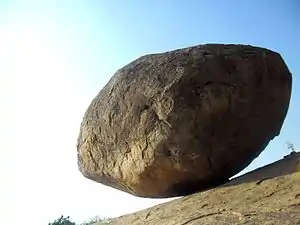 Krishna's Butter Ball, side profile viewed from east t west.
Krishna's Butter Ball, side profile viewed from east t west. "Take this path to your goal",
"Take this path to your goal",
frontal long shot viewed from south to north.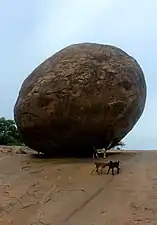 "Oh my goat",
"Oh my goat",
frontal profile viewed from southeast to northwest.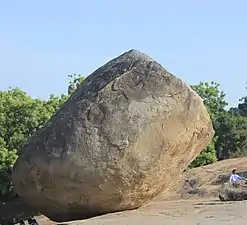 "The rock solid",
"The rock solid",
side profile viewed from east to west. "Dare to rest precariously",
"Dare to rest precariously",
side profile viewed from northeast to southwest. "Tumble, if you can",
"Tumble, if you can",
rear profile viewed from north to south. "The tricky rock",
"The tricky rock",
side profile viewed from west to east. "Have one more dollop",
"Have one more dollop",
side profile closeup viewed from southwest to northeast. "The surreal twilight zone",
"The surreal twilight zone",
side profile viewed from southwest to northeast. "The golden sunrise",
"The golden sunrise",
side profile viewed from northwest to southeast.
See also
References
| Wikimedia Commons has media related to Krishna's Butterball. |
- "Krishna's Butter Ball". Atlas Obscura. Retrieved 27 September 2016.
- Eric Grundhauser (4 August 2015). "The Delicately Balanced Beauty of Krishna's Butter Ball". Slate. Retrieved 21 May 2016.
- James G. Lochtefeld (2002). The Illustrated Encyclopedia of Hinduism: A-M. The Rosen Publishing Group. p. 399. ISBN 978-0-8239-3179-8.
- "Group of Monuments at Mahabalipuram". UNESCO.org. Retrieved 23 October 2012.
- Neha Vashishth (16 April 2016). "These Mysterious Places In India Totally Defy Gravity!". dailybhaskar. Retrieved 22 May 2016.
- https://web.archive.org/web/20180919070208/http://asi.nic.in/alphabetical-list-of-monuments-tamil-nadu/
- "Krishna's Butter Ball - Ancient Aliens In India? ~ Places on the planet you must see". Retrieved 21 May 2016.
- Ramakrishnan, T. (11 October 2019). "Camaraderie marks start of Modi-Xi 'informal summit'". The Hindu. ISSN 0971-751X. Retrieved 19 October 2019.
- Samonway Duttagupta (5 April 2016). "7 of the most incredible natural wonders in India". India Today. Retrieved 21 May 2016.
- Neha Borkar (7 February 2016). "This Is Krishna's Mysterious 'Butter Ball' Rock And It Has Never Rolled Downhill". IndiaTimes. Retrieved 29 September 2016.